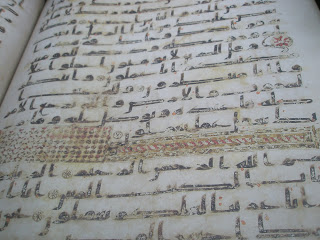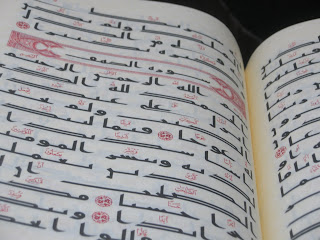In 2006 I moved to Qatar and things are not what many people in North America would expect - it is not like how the Middle East is portrayed in the media. I'm also a fan of skepticism and science so wondered how this works here in Qatar. Since I'm here for a while I figured I'd use the time to get to know this country better and with this blog you can learn along with me. - - - - - - - - - - - - - - - - - - - - - - - So what posts have been popular recently . . .
Tuesday, July 23, 2013
Ramadan 2013 – Day 13, Qur'an Calligraphy
Last night I went down to Katara to catch some of their Garangao events and happened to walk past a gallery with this sign:
That was certainly worth a look, I did a post about Qur’an calligraphy a year ago on the various styles and how they developed.
One of the first things they had was a great list showing examples of some of the styles:
It may surprise you to find out that each line of calligraphy has the same words in it. It took me a while to figure this out too. While kufic is pretty straightforward for me to read styles like diwani and diwani jali are exceedingly difficult for a beginner like me to decipher. Yet they all say the same thing. It might be in part because written Arabic is read right to left so printed Arabic tends to be very horizontal like kufic, whereas most of the styles here seem to be written almost diagonally or at a sharp angle, from the top right corner to the bottom left.
Now in my original post on calligraphy I mentioned the early Uthman Qur’ans, of which possibly two of those early Qur’ans still survive – the Topkapi Qur’an in Istanbul and the Samarqand Qur’an. At the exhibition were replica copies of both. The Topkapi is the first picture, the Samarqand second. Both are in Kufic but with slightly different style:
The exhibition then discussed the evolution of calligraphy and credits two main historical periods: in Baghdad under the Abbasid Dynasty (roughly 8th to the 13th century) and in Istanbul under the Ottoman period (16th to 20th century). Below is an example from one of the top 16th century Ottoman calligraphers, Ahmed Qurah Hasari.
While in most of the examples we see that the calligraphy is quite spaced out, not all Qur’ans were written this way:
But many were incredibly decorative, with a lot of color and artwork, not unlike the level of decoration that went into some of the Medieval Bibles:
Here's a decorative modern example for comparison:
Finally the exhibit had some copies of the earliest printed and translated Qur’ans. The first printed Qur’an was in 1694 in Germany:
The exhibit also had copies of the first Qur’ans printed in Iraq and Saudi Arabia (at the top and bottom of the picture respectively)
And the first translations of the Qur’an date from around that time. A copy in French was first produced in 1649.
It took a while after that for the first translation in English, which was published in 1734.
It was great to have seen that exhibit, especially since I had to leave Katara to meet friends before the Garangao events really started to take off (I keep forgetting things start really late here, people were only starting to show up around 10pm). At least the exhibit made the trip worthwhile.
If you're interested in seeing the exhibit it is in building 22 of Katara.
You can read more about Qur'anic Calligraphy here.
Subscribe to:
Post Comments (Atom)















No comments:
Post a Comment